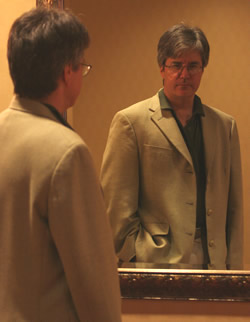Who's Watching Me?
Bob Blakley’s reflections from the Digital ID World conference
A principal analyst for identity and privacy strategies at the Burton Group, Bob Blakley gave a talk this month at Digital ID World in Santa Clara, CA, titled, “What is Privacy, Really?” In a separate interview, Campus Technology logged Blakley’s comments relative to privacy and technology in higher education:

Bob Blakley ponders privacy and identity
Conventionally, people think of privacy in terms of secrecy. They think that privacy means the obligation to protect information that we have observed, maybe in the course of our job, about other people. The point that I made [in my talk] today was that there’s another part of privacy that we don’t speak of so often, which is equally important, or perhaps more important – and that is our obligation not to pry into other peoples’ affairs; to avert our eyes or close our ears if we come across something that is obviously private. And [I spoke about] our obligation as a society to censure people who don’t fulfill that obligation, because that kind of behavior – voyeurism and gossip – is destructive to civil society. I made an argument that there may be a way to construct a right to privacy that d'esn’t currently exist in our constitution on these grounds, if it continues to be the case that lots of private information is exposed.
The academic community has, in a certain sense, been a leader in the development of technology [related to this]. When I was the first editor of the OASIS SAML specification, we had a lot of discussions about the relationship between privacy and anonymity and the ability to identify attributes of people without identifying the people themselves. The higher education community needed to be able to comply with the FERPA regulation, and needed to be able to, for example, enroll a student from one campus at another campus without revealing that student’s identity to the second campus. And what was developed on top of SAML was the protocol called Shibboleth – that was one of the initiatives that formed some of my thinking on this topic.
Higher ed is a microcosm of [privacy] regulations. The HIPPA regulation applies to the campus medical clinics, and financial privacy regulations apply to universities because they often, for example, issue ID cards to students that allow them to purchase meals at a commissary or to purchase textbooks. So, higher education encounters privacy regulations in many of its operations: health center operations, financial operations, and such, in the administration of both disciplinary records and academic records.
[In terms of related technology application areas, the example] that I’ve been most personally acquainted with, through some conversations with the Association of American Medical Colleges (AAMC) at the time the HIPPA regulation was promulgated, is telemedicine. There are a number of universities who are pioneering the use of telemedicine, especially through distribution of medical imagery over very high bandwidth connections like Internet2. For a long time this was the exclusive province of the academic community, and it created a set of electronic health record considerations that hadn’t been dealt with by anybody else in the [medical] community. So certainly, academic medical centers are really pioneering both the technology and the social context that’s going to be embedded there.
And one of the big problems in the online world is, if for every piece of data there was someone who was recognizably responsible for it, it would be so much easier to enforce privacy regulations. But the fact is, there’s a large amount of data out there that is in a certain sense, orphaned: [not necessarily abandoned], but nobody has any statutory responsibility for it. The fact that it’s out there and it d'esn’t have to be accurate and nobody’s accountable, gives you a kind of wild-west aspect to the landscape that contributes to the difficulty of solving the privacy problem.
Bob Blakley is the principal analyst for identity and privacy strategies at the Burton Group.